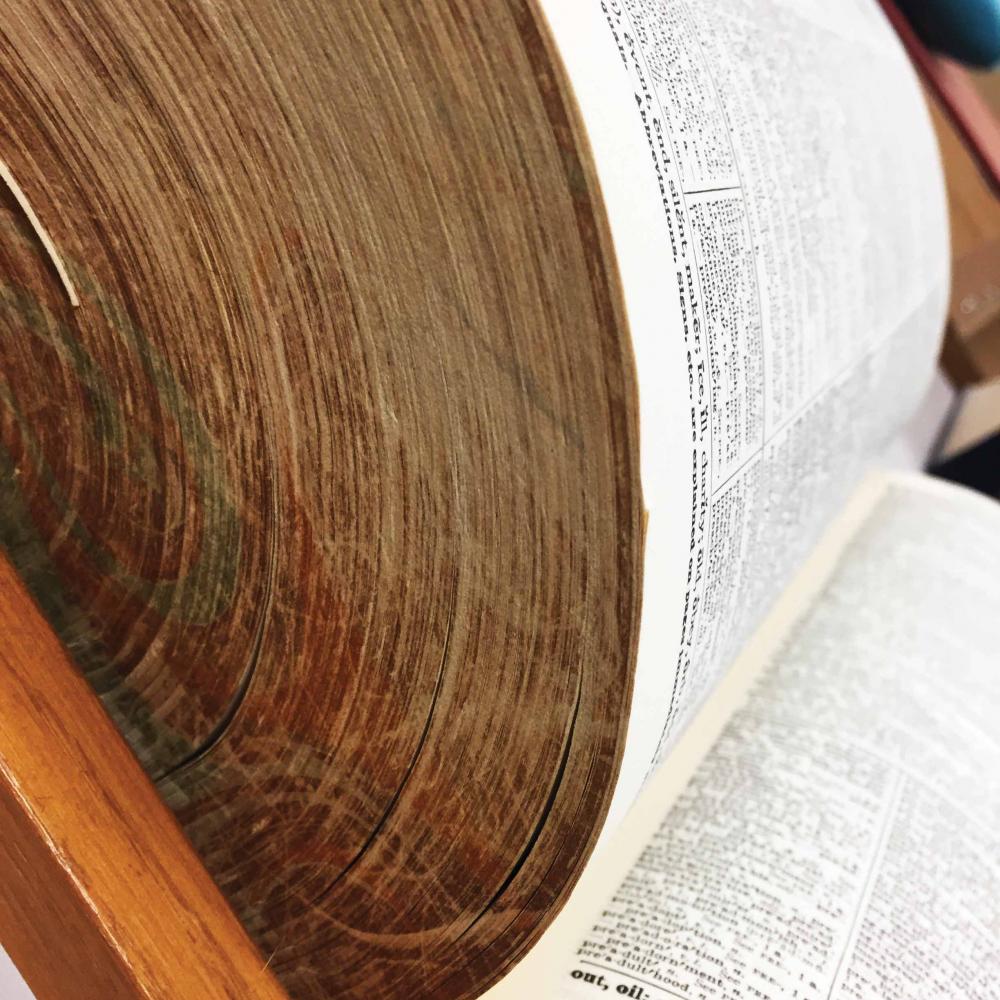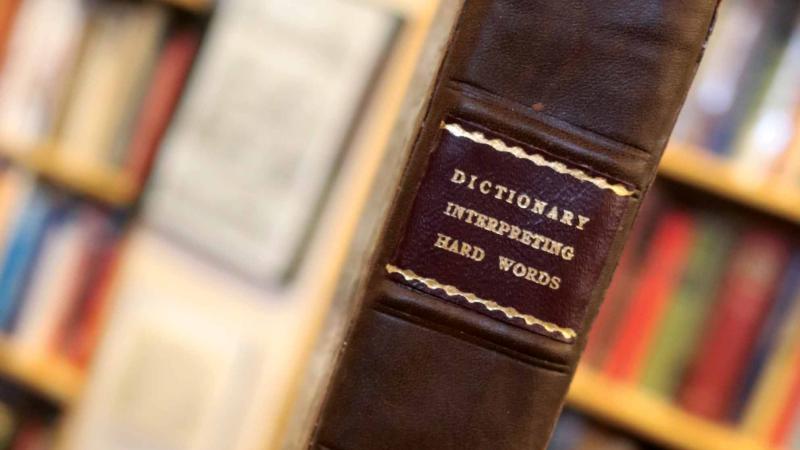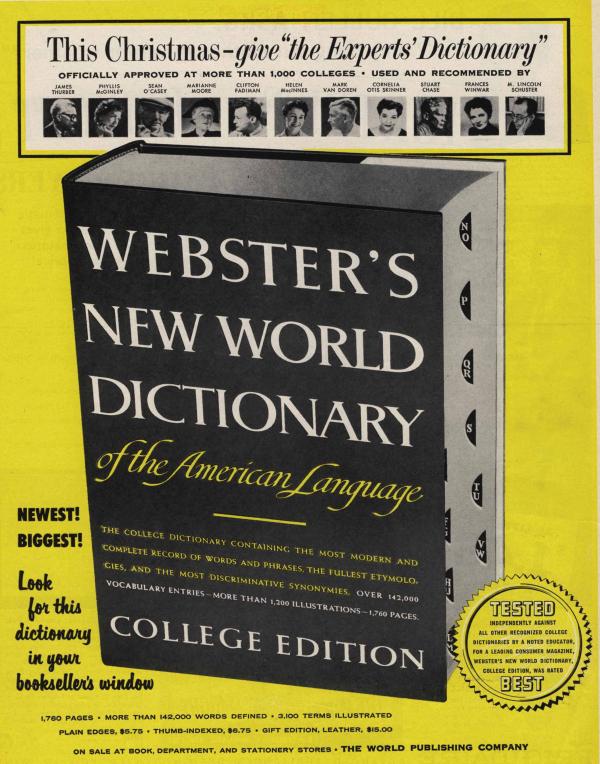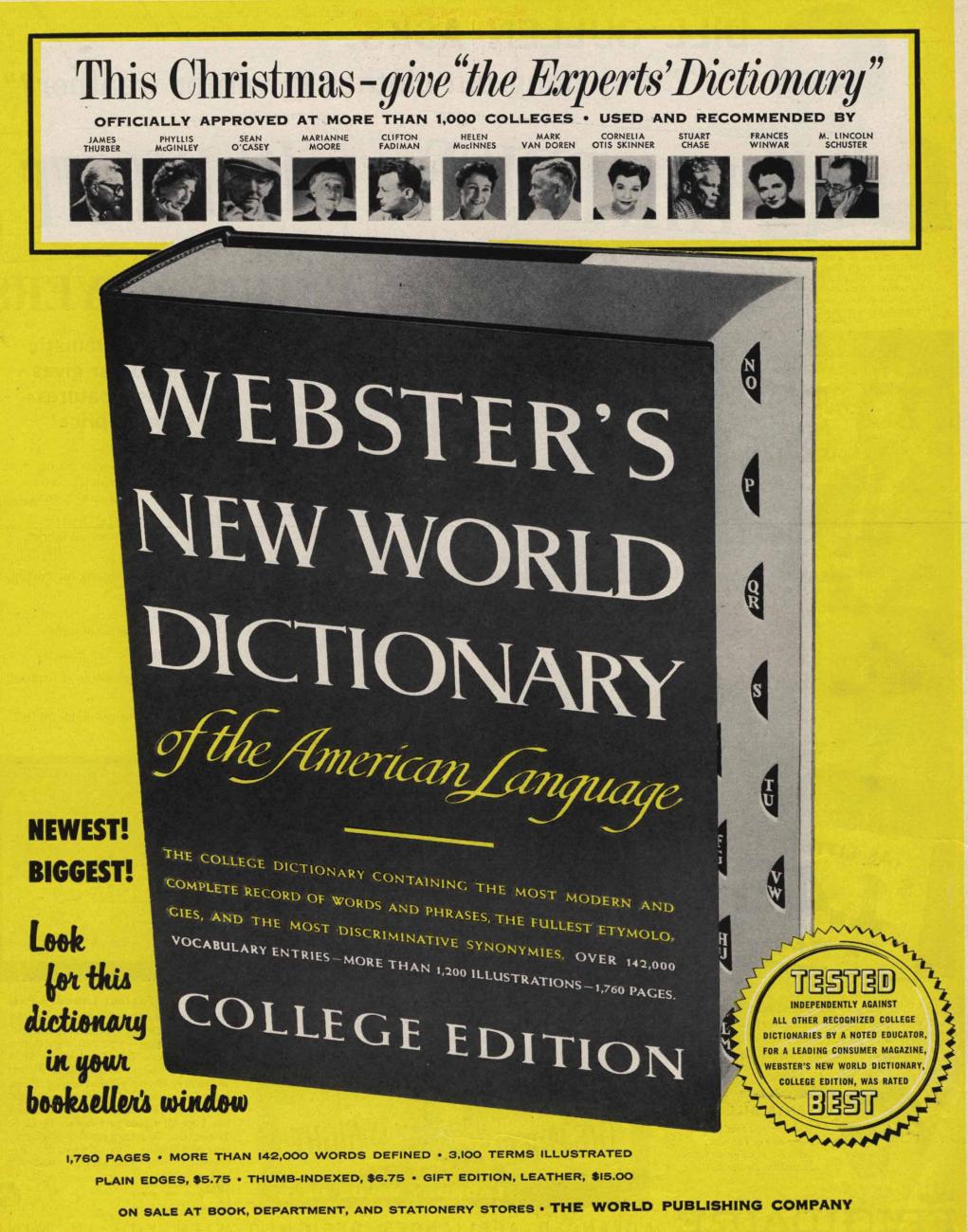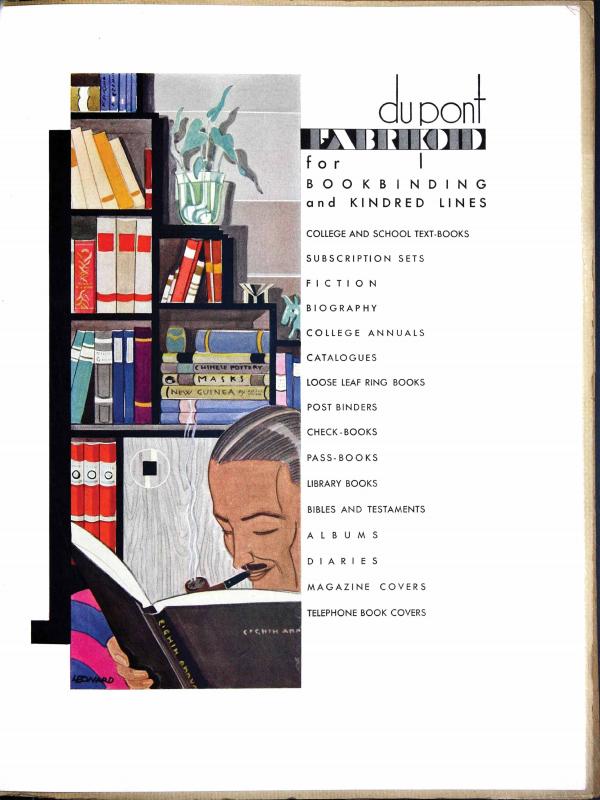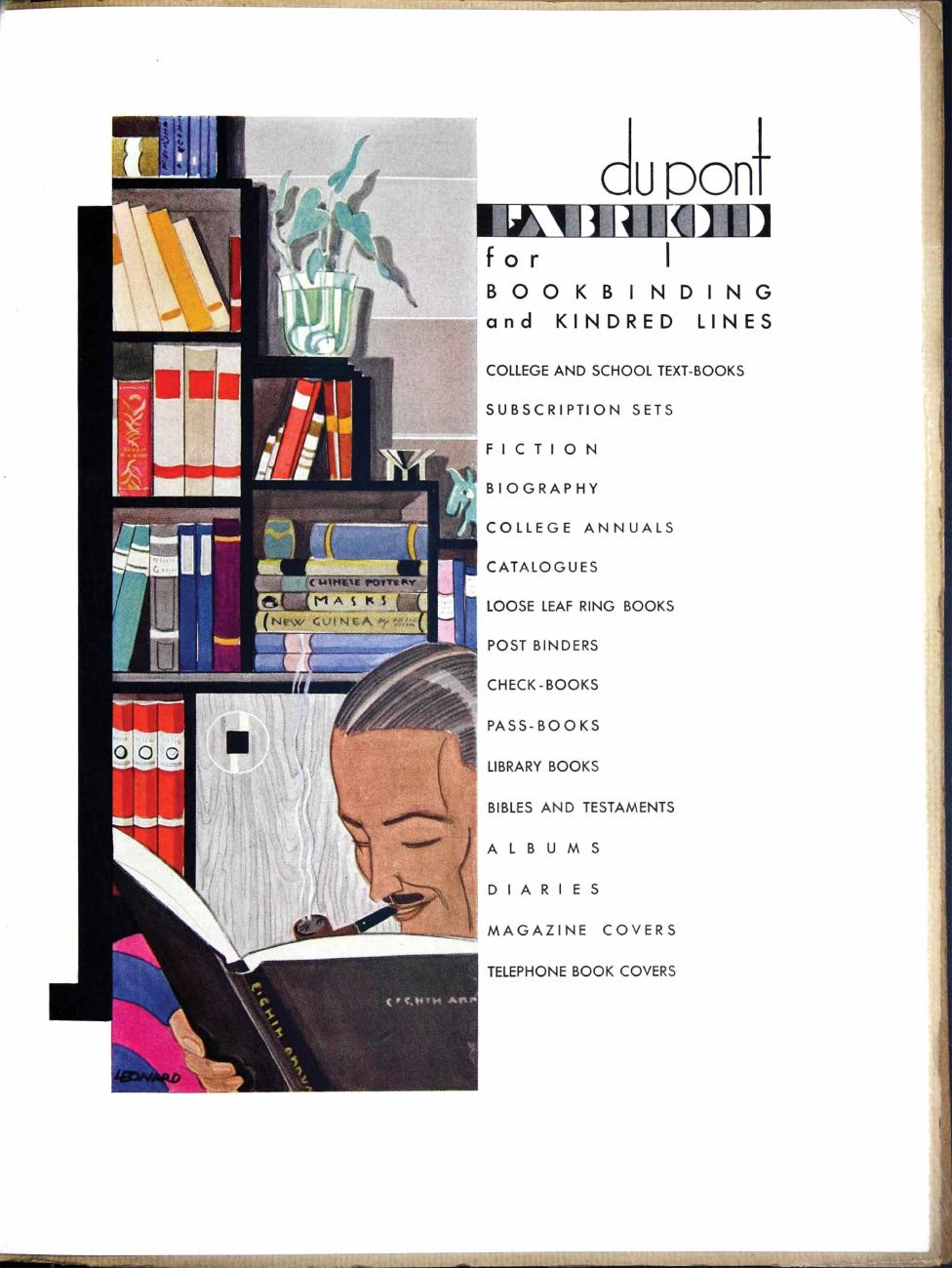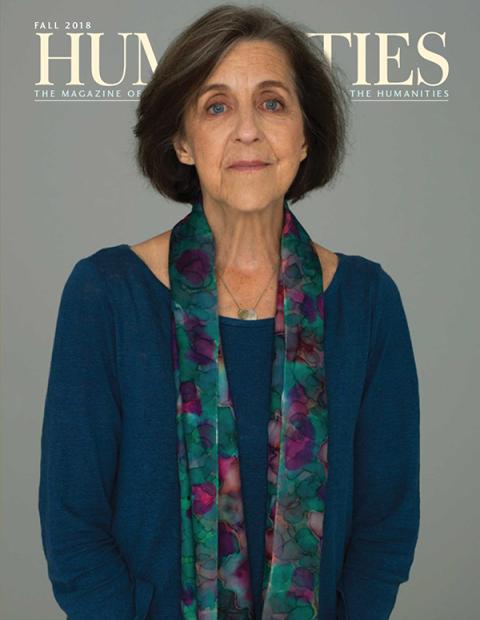General dictionaries like Webster’s Third New International and the American Heritage Dictionary of the English Language are chock-full of information about English words. They record spellings, pronunciations, meanings, and brisk etymologies. Historical dictionaries like the Oxford English Dictionary and Green’s Dictionary of Slang brim with quotations that exemplify each word’s history and indirectly comment on Anglophone culture high and low. They appeal to our thirst for lexical knowledge. They spur our imaginations. They are replete with ideas that matter, regardless of the paper on which they are printed and the particulars of their binding.
But, as anyone who grew up in twentieth-century America knows, many a dictionary stopped a door or flattened autumn leaves between waxed paper. Earlier in the year, flowers had dried within their pages. At Thanksgiving, children unable to reach their turkey sat atop the big Webster’s or Random House. Heaven help the family with too many children and too few dictionaries. Dictionaries were useful objects, but when people weren’t sitting on them or looking things up in them, they were also household ornaments that signified eloquently the social status of their owners.
Owning a dictionary implied some things: an ambition to speak and write correctly; that you thought about language. Maybe you suspected your neighbors mispronounced certain words or used them incorrectly. And you may have played the game Dictionary—someone selected a word from the dictionary and supplied the right definition while everyone else made up definitions, and then the person whose turn it was had to figure out which definition was correct. Points to the writer of a fake definition, if selected; points to the one who selected the word, if the correct definition is overlooked. Other people played Yahtzee—not that there’s anything wrong with that—but Dictionary players were a breed apart. A big dictionary on the shelf implied that you read books with words so hard you might need to look them up; or that you were a reader in search of nuance that only a big dictionary could supply.
After World War II, colleges and universities nationwide required that new students buy the American College Dictionary or the Merriam-Webster Collegiate. Like grammar handbooks, dictionaries supported learning in introductory writing courses, and, for consistency, students and faculty, it was thought, should all refer to the same one. Dictionaries became an icon of the college experience, certified the intellectual status of their owners, and marked the rising social tide of higher education. When you walked into a room and saw a dictionary, you saw it as proof that the owner belonged to your tribe, though, to be sure, you also had to find certain novels, poems, or political manifestos on shelves nearby.
As objects, dictionaries were sometimes attractive books, and when they served as gifts on special occasions, they conveyed something of the giver’s status. When Aunt Sophie wanted to reward a niece or nephew for graduating from high school with college in view, she would present the up-and-coming student with a dictionary, but not just any dictionary. It might be linen-covered; it might be printed on India paper; it might have speckled edges; it might be thumb-indexed; it might be all four. It all depended on how Aunt Sophie wanted to be seen by the rest of her family, how much she wanted to spend, and how much she liked her young relative.
Nowadays, people view dictionary entries online. They don’t view pages in the old-fashioned sense, and the digital pages don’t pile up in bulk, so you can’t speckle their edges. Some publishers—Macmillan, for instance—have stopped producing print dictionaries, and some argue that the dictionary-as-physical-object is history. Thus, it seems reasonable to treat it as such and look back to a time when dictionaries were things you could sit on, to examine them as a distinctive feature of American material culture that in all its variations implied connections between the dictionary object and its social value.
We are lucky to have a snapshot of the physical aspects of dictionaries in the 1965 edition of English Language Dictionaries in Print: A Comparative Analysis, compiled by S. Padraig Walsh and published by the reference publisher R. R. Bowker. This 56-page pamphlet reports, “More than 10 million dictionaries are sold each year and, as some 70 different editions are currently in print, ranging in price from a 25 cent vest pocket edition to the gigantic, 13 volume, $300.00 Oxford English Dictionary, the variety in size, price, and quality is bewildering to those readers who are not acquainted with the finer points of reference books compilation.”
Walsh lays out “Dictionaries in Order of Cost” and “Dictionaries in Order of Size—Entries,” provides a “Suggested Age Suitability Chart,” and summarizes salient features of 37 dictionaries, including publication history; numbers of entries, pages, and illustrations; contents and arrangement; and a summary evaluation. Here, however, we are more interested in available bindings, paper, other design and physical features, and prices, the sorts of things that assert a dictionary’s social rather than intellectual value.
Dictionaries in the 1960s weren’t all pretentious. Some were physically modest. The Funk & Wagnalls Standard College Dictionary was available in two varieties, “plain cloth” and “thumb indexed cloth.” If Aunt Sophie bought one of these for her protégé, she expected it to be a learning tool, not a trophy. As Walsh writes, this dictionary was “designed for everyday use by students and adults.” The status lay in owning a sophisticated variety of dictionary, a college dictionary with an “excellent binding, large clear, easy to read type, strong, [and] top quality paper,” as Walsh puts it.
Webster’s Seventh New Collegiate Dictionary, on the other hand, was bound in myriad ways. If Aunt Sophie’s niece was an unlikely dictionary user, tan cloth would have sufficed. If she worked hard, liked nice things, and took care of them, blue linen may have been more appropriate, a more valuable binding that thereby valued the niece more highly. If she was a grind and somewhat careless, Aunt Sophie could protect the dictionary with a red Fabrikoid binding. If the dictionary is a bible of words and usage, then perhaps it should have been a Bible binding, in black leather. If the niece was valedictorian and Aunt Sophie spent to prove her own status—and these motives aren’t mutually exclusive—then elegant pigskin, in blue or brown, would have fit the circumstances like a glove.
Prices reveal social value hand in hand with the bindings. Merriam-Webster’s tan cloth cost $5.75 in 1965, the blue linen $6.75, and the red Fabrikoid $8.75. Today these price differences seem trivial, but once you recalculate the 1965 dollar into its current value of $8.00, the prices are surprisingly high. Today’s print dictionaries—what’s left of them—may be less expensive than their ancestors, but they aren’t in similar demand. So, the eleventh edition of Merriam-Webster’s New Collegiate retails at $27.95, but at the very moment of this writing, Amazon lists it at $11.98, which is to say that folks valued dictionaries more in 1965 than they do today.
Back in the 1960s, books carried a certain authority. If you had a predigital dictionary on a stand or a shelf, or even holding a door open, it didn’t just provide access to that authority or associate you with learning—you owned the learning and authority. Sure, dictionaries were more expensive, but in those days people were willing to sacrifice a bit, if they could have that authority in the living room or dorm room, or if it projected the image of learning and authority on a graduation gift. Thus, Aunt Sophie chose among a tan cloth version costing $46.44 in today’s dollars, a blue linen one at $54.52, and a Fabrikoid at $70.65. At $12.50 ($100.96), black leather binding more than doubled the cost and value of a basic tan cloth dictionary. The pigskin binding—$15.00 ($121.15)—distinguished the book but also its owner and giver as people of taste and means.
There’s a story about postwar economics implied by these prices. The Funk & Wagnalls Standard College Dictionary, utilitarian in its materials, was offered at a price most college or college-bound students could afford, $6.50 ($52.50) for the plain cloth, thumb indexed for $7.50 ($60.57). The Merriam-Webster dictionaries accommodated even smaller pocketbooks, but, in stratifying so far beyond that basic version and basic price, they also demonstrated the hierarchy of classes and subclasses developing then in American culture. The variety of choices indulged a new consumerism.
How upscale or aspirational was owning a Fabrikoid-bound dictionary? The American College Dictionary defines fabrikoid as “1. a waterproof fabric having a cloth foundation and a pyroxylin surface used as a substitute for leather, cloth, etc. 2. (cap.) a trademark for it.” I was surprised to find the term among ACD’s 132,000 entries—I can’t imagine that fabrikoid is one of the 132,000 most important words for American college students to know. Yet it’s appropriate that ACD defines it, because you shouldn’t bind your dictionary in something the word for which it doesn’t define. Thus, ACD defines buckram as “stiff cotton fabric for interlining, binding books, etc.”
Another way to prove you’re a gentleperson and a scholar is to own a really big dictionary, one that’s uncomfortable on the lap, one that demands a hardwood book stand, like Webster’s Third New International Dictionary. “Weight varies from 10½ to 15 lbs. depending on binding,” Walsh explains, so it needs an “Excellent sturdy binding to take considerable weight of volumes.” In 1965, this imposing dictionary was bound in buff buckram with regular paper at $47.50 ($383.64) or with India paper at $55.00 ($444.21). Or you could have it in Fabrikoid, with or without India paper, for $59.50 ($480.56) and $52.50 ($424.02), respectively. Honestly, any of these options meant spending a lot of money, and while the expense could be justified by the contents of the dictionary, it was also justified by the way a big dictionary makes one feel, and what having it in your living room says about you to all who see it.
Webster’s Third is big—it’s impressive—but it’s not the biggest dictionary of English and, as the Oxford English
Dictionary proves, at 13 volumes in 1933, size matters. Webster’s Third, according to Walsh, beats the OED in number of entries, 450,000 to 414,825. But the OED occupies 16,476 pages, a giant of lexicography beside the large-enough-for-most-people Webster’s Third at 2,720 pages. Of course, the OED has an elaborate analytical structure and all of the quotations required of a superb historical dictionary, so there’s an intellectual justification for the bulk, but 13 volumes dedicated to English words sends a social message very different from that of a single unabridged volume. Back in 1965, the OED cost $300 or $2,422.97 in today’s dollars; today, one can purchase the 20-volume OED for £850, at this writing, $1,131. Walsh notes that the OED was “available in one edition only. . . . Bound in blue Buckram,” and that’s true of the twenty-first-century OED, too. If you’re as all-encompassing as the OED, you needn’t cater to superficial social pretentions.
The Compact OED, however—two volumes, four original OED pages to a page—confounds the OED’s loftiness to some degree, because, owning it, one achieves status without the commitment implied by 13 or 20 volumes. Some people need an OED and can’t afford the massive version. My father, an English professor, had the Compact on his shelves, and he used it all the time. The Compact was a premium of the Book of the Month Club—given the contents, it was basically free. When I left for university, I had a copy, too. I was used to it. While the magnifying glass required to read it probably discouraged some use, it fascinated a boy like me—the opportunity of using the glass drew me to the dictionary text. So, the OED was democratized, the terms on which it conferred status altered in the trade book marketplace.
Many—probably not all—people who owned the big dictionaries back in 1965 used them to look up words, even if they also used them to stop doors, boost the short leg at the dinner table, or impress visitors. But how much of what they looked up could be found more easily in a college dictionary? Some wanted to be prepared for the rare rare word, for which only the unabridged dictionary could provide an adequate explanation. There’s no need to be cynical—big dictionaries served legitimate intellectual purposes. But given the average level and frequency of use, the size, and the buckram and speckling, those weren’t the only purposes they served.
The commodification of dictionaries was not new in 1965 or even in the second half of the twentieth century. Seventeenth-century English dictionaries were pretty basic—in content, method, and design—and even Samuel Johnson’s dictionary, which certainly had intellectual pretensions, was published in plain boards, though people of means arranged bespoke bindings. However, the second half of the eighteenth century saw a rising vogue in octavo and miniature dictionaries, small enough to deposit in one’s pocket or purse, handy for looking things up on the fly, in a street or a parlor, but also a personal, portable decoration. And there’s no reason to assume dictionaries are made only with lexicographical motives. The OED, for instance, was not just a great historical dictionary but a national dictionary, proof that the English had a language and a dictionary to rival German and the Grimms’ Deutsches Wörterbuch. If a good-looking dictionary makes you look good, why not buy it? Modern dictionary makers once colluded with dictionary owners in satisfying that impulse.
But now, in the twenty-first century, it’s not clear that dictionaries-as-physical-objects will persist, and, even if they do, surely their cachet will be diminished. Digital dictionaries are practically useless: It would be reckless to stop a door with your laptop, and you can’t raise children to table level by having them sit on your phone.
In the Information Age, dictionaries have been reduced to their information. You will find fewer big print dictionaries open on cherry book stands in American living rooms. I can testify that undergraduates don’t carry Fabrikoid-bound dictionaries in their backpacks, and—given the animal rights movement—resurging pigskin dictionary fashion seems unlikely, too. Will people of the word—people who love language, but nevertheless consult online dictionaries—figure out ways to display their wordiness in worldly ways, establishing public identities like those that dictionaries helped establish in the previous century?
Imagine walking into a large, sunlit room of ultramodern design, a room designed like an iPhone. At one end, you see a screen on a stand. You walk up to it and note several icons, all of which lead to dictionaries. One represents the OED, another Green’s Dictionary of Slang, and yet another the Dictionary of American Regional English (DARE). There’s a digital edition of Hobson-Jobson, the Anglo-Indian dictionary—you didn’t know there was one! The owner of this screen, this room, this apartment, lives an urban life now, but never abandoned her roots, which is why there’s an icon for Michael B. Montgomery and Joseph S. Hall’s Dictionary of Smoky Mountain English right there next to the OED icon, the historical equipoise of standard and nonstandard varieties of English represented on a sleek screen. This lady knows her language.
The display materializes the immaterial dictionary texts and it associates its owner—its producer—with lexical learning and the cultural information embedded in quotations dictionaries. Also, given the production values, it aligns knowledge and style in the same way that leather or pigskin bindings once did. It partially expresses the owner’s identity, and doing so is important to the owner. The dictionary consumption is conspicuous, not just because of its place in interior design, but because the annual subscriptions to the OED, DARE, and Green’s Dictionary of Slang ring in at $295, $49, and $66, respectively, a total of $410, more than anyone used to spend annually on dictionaries, and the figure would be greater still if there were a digital version of the Dictionary of Smoky Mountain English, whose price would add to the cost.
You approach the altar of lexical knowledge. What is this Hobson-Jobson thing? You open it with the tip of your finger on the screen, turn a few pages, and land on the entry for “COMBOY. A sort of skirt or kilt of white calico, worn by Singhalese of both sexes, much in the same way as the Malay Sarong.” Singhalese and Malaysians, comboys and sarongs—the world is new to you, geographically and historically, but, of course, that’s why you’re off to university in the fall, to learn as much about it as you can in four years. You hadn’t realized that a dictionary is a window into that world. You’re about to look at another entry, but you’re interrupted when Aunt Sophie enters the room.
You show her what you’ve just read and remark how you didn’t know there was an Anglo-Indian dictionary called Hobson-Jobson—why is it called that, anyway? Aunt Sophie explains that the answer is in the dictionary itself, which is easily consulted, she continues, because you can read it page by page, though it’s also fully searchable. You remark that it’s beautifully printed—in the digital sense—and tell her what you’d just been telling yourself, that you’re excited to learn more things when you’re an undergraduate. Aunt Sophie agrees, explaining that it’s a special deluxe edition, that you can find Hobson-Jobson free online, but scrolling and searching isn’t like reading by turning a page. Dictionaries, she says, aren’t just for looking things up but for looking around in language, for reading, like other books. Aunt Sophie has her phone in hand as you talk, searching, scrolling, touching, and then smiling, as she holds it out to you, where you see that she’s sent you your very own copy of the deluxe digital Hobson-Jobson—it’s in your mail, ready for downloading. Consider it another graduation present, she says.
You may be the only person in your residence hall to own a deluxe copy of Hobson-Jobson. If so, it says something about who you are or who you hope to be. At least some people to whom you show it will be impressed and think it’s cool. And what if you say something in class that reveals your knowledge of Hobson-Jobson, and someone comes up to you afterward and reveals her own knowledge of it, while admiring yours? Then, she pulls out her tablet and shows you the icon, and what else can you do but the same? You’ve recognized each other, just as you would have by seeing the “right” dictionary in the right binding on a dorm room bookshelf in 1965.
The icon is the binding, searchability is the thumb index. The history of print dictionaries-as-physical-objects tells us that it’s not the same, but using a digital dictionary turns out to be as material as knowledge in the digital present can be—plus ça change, plus c’est la même chose. Well-designed digital dictionaries can serve the same social purposes as their printed forebears—express one’s identity, one’s aspirations, one’s status as registered by various forms of consumption and various modes of utility and style. They can’t stop doors. They can’t substitute for booster seats. From a sleek screen on a stand, however, dictionaries can still furnish a room.

